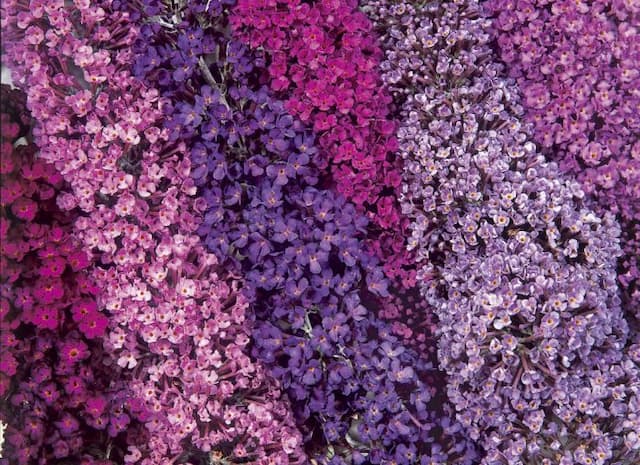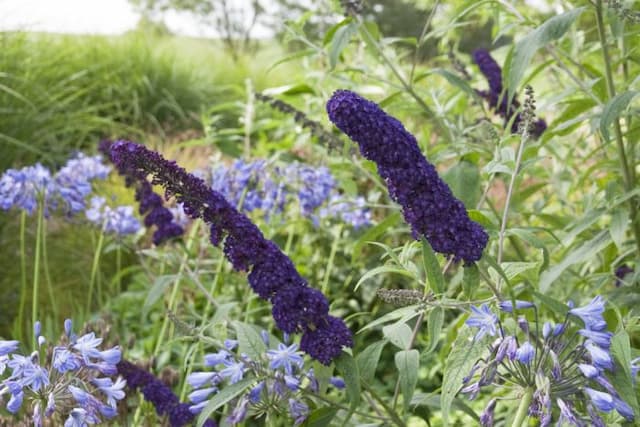Nemesia Nemesia 'Fleurie Bluebird'

ABOUT
The Nemesia 'Fleurie Bluebird' is a striking flowering plant that boasts a vibrant display of colors. Its blossoms are particularly noteworthy, with a rich shade of blue that is often highlighted by a delicate white center, creating a pleasing contrast. The petals have a velvety texture with a tubular shape that fans out into five lobes at the ends. This intricate bloom shape is typical of the Nemesia genus, giving it a playful and almost whimsical appearance. The foliage of the 'Fleurie Bluebird' is equally attractive. The leaves are generally a bright, glossy green, which forms a lush backdrop to the vivid blue flowers. They are often lance-shaped, with a slightly serrated edge, and grow densely to create a full and bushy appearance for the plant. Together, the blooms and foliage bring a refreshing coolness to any garden space, reminiscent of a clear blue sky on a sunny day. The overall look of the Nemesia 'Fleurie Bluebird' is one of casual elegance. Its stunning flowers are large enough to be eye-catching and are produced in abundance, often covering the plant in a sea of blue during its blooming season. The sight of a 'Fleurie Bluebird' in full bloom is a captivating spectacle that can add both visual interest and a touch of serenity to settings ranging from garden beds to containers.
About this plant
 Names
NamesFamily
Scrophulariaceae
Synonyms
Cape Jewels, Nemesia
Common names
Nemesia 'Fleurie Bluebird'
 Characteristics
CharacteristicsLife cycle
Annuals
Foliage type
Deciduous
Color of leaves
Green
Flower color
Blue
Height
1 foot [30 cm]
Spread
1 foot [30 cm]
Plant type
Herb
Hardiness zones
9
Native area
South Africa
Benefits
 General Benefits
General Benefits- Aesthetic Appeal: Produces beautiful blue flowers that can enhance the visual appeal of gardens or landscapes.
- Attracts Pollinators: Attracts bees and butterflies, which are essential for pollination and maintaining healthy ecosystems.
- Ease of Growth: Nemesia is known for being easy to grow, suitable for gardeners of all skill levels.
- Long Blooming Period: Has a prolonged flowering period, providing color from spring to fall.
- Compact Size: Its compact size makes it suitable for small gardens, borders, containers, or window boxes.
- Low Maintenance: Requires minimal care once established, making it a convenient choice for busy gardeners.
- Versatility: Can be used in a variety of garden designs, from cottage gardens to modern landscapes.
- Seasonal Interest: Adds interest to the garden in seasons when other plants may not be flowering.
 Medical Properties
Medical PropertiesThis plant is not used for medical purposes.
 Air-purifying Qualities
Air-purifying QualitiesThis plant is not specifically known for air purifying qualities.
 Other Uses
Other Uses- Nemesia flowers can be pressed and used in crafting, such as in homemade cards or bookmarks, adding a touch of natural beauty to paper crafts.
- The petals of Nemesia can be used to create natural dyes for fabrics, offering a range of colors from the flowers' varied hues.
- These plants can be a vibrant addition to fairy gardens, their small and colorful blooms creating a magical ambiance in miniature landscapes.
- Nemesia can be used as a living mulch in the garden, with its dense growth habit helping to suppress weeds and retain soil moisture.
- When dried, Nemesia flowers can be incorporated into potpourri mixes to add color and a light fragrance to a room.
- Nemesia's colorful presence can be utilized in educational settings, such as schools or nature centers, to teach children about pollination and plant growth.
- The plant's rapid growth and blooming can be used as an indicator of the growing season's start for gardeners in temperate climates.
- Nemesia can be grown as part of a sensory garden, providing an array of colors, textures, and scents to stimulate the senses.
- For photographers and artists, Nemesia flowers can serve as an attractive subject or backdrop for photographs and paintings.
- Used in culinary presentations, edible varieties of Nemesia can be a colorful garnish to decorate plates and add an edible floral element to cuisine.
Interesting Facts
 Feng Shui
Feng ShuiNemesia is not used in Feng Shui practice.
 Zodiac Sign Compitability
Zodiac Sign CompitabilityNemesia is not used in astrology practice.
 Plant Symbolism
Plant Symbolism- Optimism: The bright and cheerful blossoms of the Bluebird Nemesia often symbolize a positive outlook and hope for the future.
- Friendship: Given as a gift, Bluebird Nemesia may convey a sense of camaraderie and affection between friends, akin to the song of a bluebird that is often associated with happiness.
- Joy: The vibrant colors of this plant can evoke feelings of joy and delight, making it a symbol for the simple pleasures in life.
- Fascination: Nemesia, in general, is known to symbolize fascination, and the 'Fleurie Bluebird' with its unique blue hue can represent enchantment with the natural world.
- Gratitude: The plant may also be an expression of thanks, making it an appropriate token of appreciation for kindness received.
 Water
WaterNemesia, also known as Cape Jewels, prefers evenly moist soil, so it's important to water it thoroughly when the top inch of soil feels dry to the touch. This can mean watering approximately once or twice a week, depending on the climate and weather conditions. It’s best to use a gentle shower from a watering can or hose attachment to mimic natural rainfall when watering Cape Jewels. In terms of the amount, aim to provide about one to two gallons of water weekly, making sure to avoid waterlogging the soil, as this can lead to root rot.
 Light
LightFor the best growth, Cape Jewels require full sun to partial shade conditions. They thrive when they receive at least 4-6 hours of direct sunlight per day. A spot that is sunny in the morning but shaded during the hottest part of the afternoon is often ideal. Avoid placing Cape Jewels in deep shade, as this can hinder flower production and lead to leggy growth.
 Temperature
TemperatureCape Jewels do best in moderate temperatures and can typically handle a range from about 40°F to 80°F. They prefer cooler conditions and can suffer in hot weather, especially if temperatures exceed 85°F regularly. To promote prolonged flowering, keep them in an environment where nighttime temperatures are between 50°F and 60°F.
 Pruning
PruningPruning Cape Jewels encourages bushier growth and more abundant blooms. Deadhead spent flowers regularly to promote new ones. You can also lightly prune the plant throughout the growing season to maintain its shape. The best time for major pruning is in the late winter or early spring, just before new growth begins. Trim back leggy stems by about a third to help rejuvenate the plant.
 Cleaning
CleaningAs needed
 Soil
SoilNemesia 'Fleurie Bluebird', commonly known as Cape Jewels, thrives best in a well-draining, fertile soil mix with a pH range of 5.5 to 7. A mixture of loamy soil, peat, and sharp sand or perlite is ideal to ensure good drainage and aeration. Regular enrichment with compost or a balanced, slow-release fertilizer will support its growth and flowering.
 Repotting
RepottingCape Jewels should be repotted annually, or as soon as they outgrow their current container. This process encourages fresh growth and allows you to refresh the soil mix, thus maintaining its nutrient-richness and good drainage properties. Gently tease the roots while repotting to stimulate growth.
 Humidity & Misting
Humidity & MistingCape Jewels prefer moderate humidity levels but are adaptable to a range of conditions. However, avoid very high humidity as this can encourage fungal diseases. Striking a balance near 50% relative humidity is ideal for these plants.
 Suitable locations
Suitable locationsIndoor
Place Nemesia in bright indirect light indoors.
Outdoor
Ensure full sun to part shade and protect from harsh elements.
Hardiness zone
9-11 USDA
 Life cycle
Life cycleNemesia 'Bluebird' begins its life cycle as a dormant seed which will germinate in response to the appropriate conditions of warmth and moisture, typically in spring. Upon germination, it develops a root system and a small set of initial leaves, entering its vegetative stage where it will grow rapidly. As it matures, the plant produces a profusion of distinctive blue flowers, marking its flowering stage, which is key for reproduction and attractive to pollinators. After pollination, the flowers will develop into seed pods, culminating in the seeds' dispersal, which completes the reproductive stage. Outside of ideal climates, Nemesia 'Bluebird' may behave as an annual, dying after setting seed, but in milder climates, it may survive as a perennial, going dormant over winter only to regrow from its root system the following spring. Throughout its growing season, regular deadheading can encourage additional blooming cycles and extend its vibrant display.
 Propogation
PropogationPropogation time
Spring to Summer
Nemesia 'Fleurie Bluebird', commonly referred to simply as Nemesia, is a vibrant flowering plant often propagated in the early spring to ensure that the temperatures are mild enough for the young plants to establish themselves. The most popular method of propagation for Nemesia is through seed sowing. Seeds can be sown indoors about 6 to 8 weeks before the last expected frost date to ensure that they are ready to be planted out after the danger of frost has passed. When sowing seeds, lightly press them into a well-draining seed starting mix and keep the soil moist but not waterlogged. The ideal temperature for germination is between 65 and 70 degrees Fahrenheit (18 to 21 degrees Celsius). Seedlings usually emerge within 10 to 14 days and should be gradually acclimatized to outdoor conditions before transplanting into the garden or into individual pots.


![Butterfly bush [Adonis Blue]](/_next/image?url=https%3A%2F%2Fplants-admin.emdemapps.com%2Fimages%2Fplants%2F%2Fimages%2F604b56e58f983.png&w=640&q=75)


![Butterfly bush [Buzz Ivory]](/_next/image?url=https%3A%2F%2Fplants-admin.emdemapps.com%2Fimages%2Fplants%2F%2Fimages%2F604b57987dfa8.png&w=640&q=75)
![Butterfly bush [Camberwell Beauty]](/_next/image?url=https%3A%2F%2Fplants-admin.emdemapps.com%2Fimages%2Fplants%2F%2Fimages%2F604b5ead04c12.png&w=640&q=75)


